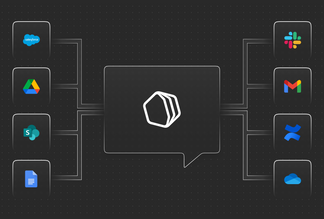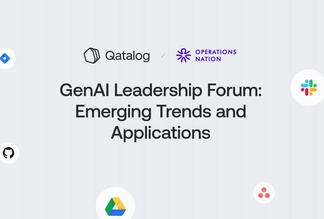
Is your business ready for generative AI?
Generative AI-powered tools offer huge potential to create operational efficiencies, boost creativity, streamline processes, and drive revenue. Unsurprisingly, many companies are eager to take advantage of these opportunities, but not all of them are prepared for what this means in practice.
Before you start your generative AI journey, here are a few questions you should ask yourself.
What are you trying to achieve?
It might sound obvious, but if you’re going to get the most out of an AI tool, start by asking yourself what particular challenge you need to solve. There might be some overarching objectives to increase efficiency or improve decision-making, but the specifics will often depend on the type of business and individual department.
For instance, your finance and accounting team might want instant access to company-wide financial reports or to be able to generate forecasts with real-time data. Sales and marketing might want to quickly gather insights from the pipeline so that they can analyze and optimize them for future campaigns. Or your customer service team may want to synthesize customer feedback across different channels to identify regular and recurring issues and tackle them easily.
Generative AI is enormously powerful, but it’s not a silver bullet. However, if you can identify the critical areas of the business where it can make a difference, it’s much easier to find the right solutions and implement them effectively.
Do you have a deployment strategy?
Whatever solution you choose, it also needs a clearly thought-out deployment strategy if it’s going to be widely adopted across the company.
Even if this new generative AI-powered tool offers lots of benefits, it can be harder than you think to change people’s habits and workflows. Solutions with simple and intuitive user interfaces can make a big difference, as this reduces the barrier to get started and find value quickly, but it’s likely you’ll need to be proactive too.
This is where internal communications are critically important. Outline the objective, explain why you’ve chosen the tool or solution, and be clear as to how people should use it. This could be in all-company emails, internal newsletters, or all-hands meetings, and it might take a few months for the message to get through. Internal training sessions might also be needed for those who need a bit more help getting up to speed. Another good idea is to identify the team that needs it most and focus there first. They will then become your internal champions and help convince others to make the switch.
Then there are the technical considerations. Does it integrate with your existing tool stack? Which integrations will be most important and will they be functional by the time you launch internally? You might only get one chance to get everyone’s buy-in for a new tool, so it’s important to give yourself the best chance and make sure everything is working when you roll it out to everyone.
Can you keep your data safe?
Very often, the real value of generative AI is unlocked when it has access to enterprise data, but this clearly has very significant implications for data security and privacy. Governments, international organizations, and policymakers are aware of these risks. That’s why numerous acts and frameworks, including the NIST, ISO, and ENISA, exist to keep data safe and secure. But these are not the only things to look out for.
Lots of generative AI solutions that use information retrieval rely on something known as a data-index. Primarily created using vector databases, they serve as a semantic bridge, connecting a user’s keyword or query to the information they’re searching for. The major downside to this approach is that it requires all your enterprise data to be duplicated and stored in vector form. This creates a single point of failure, and if this data-index is breached, all of your enterprise data could be exposed (as vectorized information can be easily reversed). This is where the benefits of generative AI should be carefully weighed up against the risks.
But there are alternatives. For example, Qatalog uses live API retrieval, which means all of your enterprise data stays safe where it is, and the results are always from real-time information, rather than the latest update to the index.
Should you build or buy?
Up until now, we’ve generally assumed that you’re looking at buying a generative AI solution. But some companies have taken the plunge and built their own, purely for their own employees to use.
Typically these are very large companies with deep technical expertise in generative AI, lots of software engineering resources, lots of computational power available, and large financial resources. Take McKinsey, which boasts 45,000 employees and more than $15 billion in revenue. It has created a generative AI platform known as Lilli for internal use. McKinsey said Lilli enables the “synthesis of the firm’s vast stores of knowledge to bring our best insights, quickly and efficiently, to clients.” Stripe also appears to have done something similar by creating its own internal LLM. According to the founder and CEO, Patrick Collinson, one-third of its employees were using it every week earlier this year.
Of course, the advantage of this approach is that you can build a solution that fits your exact needs. But there are major risks too, even if you have the resources to make it happen. Firstly, there’s no guarantee you’ll be able to reach parity with external platforms. Second, even if you can, it will likely require significant and ongoing investment to maintain and improve it, in order to keep pace with the market. Finally, it’s possible (and arguably likely) that a brand new technology comes along that completely supersedes what you’ve built.
That’s why, for most companies, buying a generative AI solution from a third party will be a better option.
A decision or a necessity?
In summary, the journey towards integrating generative AI into your organization a clear understanding of your goals and a strategy for successful deployment. There are rich rewards if you get it right, however, it is not without its challenges. It necessitates not only a technological shift but also a cultural one, with commitment to training, a willingness to adapt to new processes, and a vigilant approach to data security.
Ultimately, however, many businesses will be aware that generative AI will create significant competitive advantages for the first movers. In this new world, the decision may look like less of a choice and more of a necessity.
Qatalog leverages generative AI to enable seamless access to company knowledge, more informed decision-making, and significant operational efficiencies. Book a demo to learn more.



